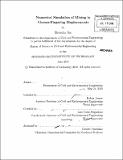| dc.contributor.advisor | Ruben Juanes and Luis Cueto-Felgueroso. | en_US |
| dc.contributor.author | Jha, Birendra. S.M. Massachusetts Institute of Technology | en_US |
| dc.contributor.other | Massachusetts Institute of Technology. Dept. of Civil and Environmental Engineering. | en_US |
| dc.date.accessioned | 2011-01-26T14:28:09Z | |
| dc.date.available | 2011-01-26T14:28:09Z | |
| dc.date.copyright | 2010 | en_US |
| dc.date.issued | 2010 | en_US |
| dc.identifier.uri | http://hdl.handle.net/1721.1/60809 | |
| dc.description | Thesis (S.M. in Transportation)--Massachusetts Institute of Technology, Dept. of Civil and Environmental Engineering, 2010. | en_US |
| dc.description | Cataloged from PDF version of thesis. | en_US |
| dc.description | Includes bibliographical references (p. 97-100). | en_US |
| dc.description.abstract | Mixing of two fluids in viscously unstable displacements is far from being fully understood. It is not known how mixing efficiency depends on the viscosity contrast between the fluids, especially for advection-dominated flows (Peclet number Pe > 103). It is well known that when a less viscous fluid displaces a more viscous fluid, the displacement front is unstable and leads to the formation of a pattern known as viscous fingering. However, current simulation technology is unable to cope with large viscosity contrasts (M > 30). We develop a high-resolution simulation approach that is stable for arbitrary viscosity ratios, and we study mixing under different canonical configurations with viscosity contrasts up to M = 400. We explain the observed evolution in degree of mixing through numerical simulation and dimensional analysis. We compute degree of mixing from decay in concentration variance and relate it to the stretching of material interface between the fluids due to fingering. Our analysis predicts the optimum range of viscosity contrast and Peclet number that maximize fluid-fluid interfacial area by balancing the number of fingers with their length before diffusive mixing across the sharp interface takes over. Interesting fingering patterns such as channeling and tip-splitting play an important role in this balancing act which makes degree of mixing a non-monotonic function of viscosity contrast and Peclet number. | en_US |
| dc.description.statementofresponsibility | by Birendra Jha. | en_US |
| dc.format.extent | 100 p. | en_US |
| dc.language.iso | eng | en_US |
| dc.publisher | Massachusetts Institute of Technology | en_US |
| dc.rights | M.I.T. theses are protected by
copyright. They may be viewed from this source for any purpose, but
reproduction or distribution in any format is prohibited without written
permission. See provided URL for inquiries about permission. | en_US |
| dc.rights.uri | http://dspace.mit.edu/handle/1721.1/7582 | en_US |
| dc.subject | Civil and Environmental Engineering. | en_US |
| dc.title | Numerical simulation of mixing in viscous-fingering displacements | en_US |
| dc.type | Thesis | en_US |
| dc.description.degree | S.M.in Transportation | en_US |
| dc.contributor.department | Massachusetts Institute of Technology. Department of Civil and Environmental Engineering | |
| dc.identifier.oclc | 696009766 | en_US |
